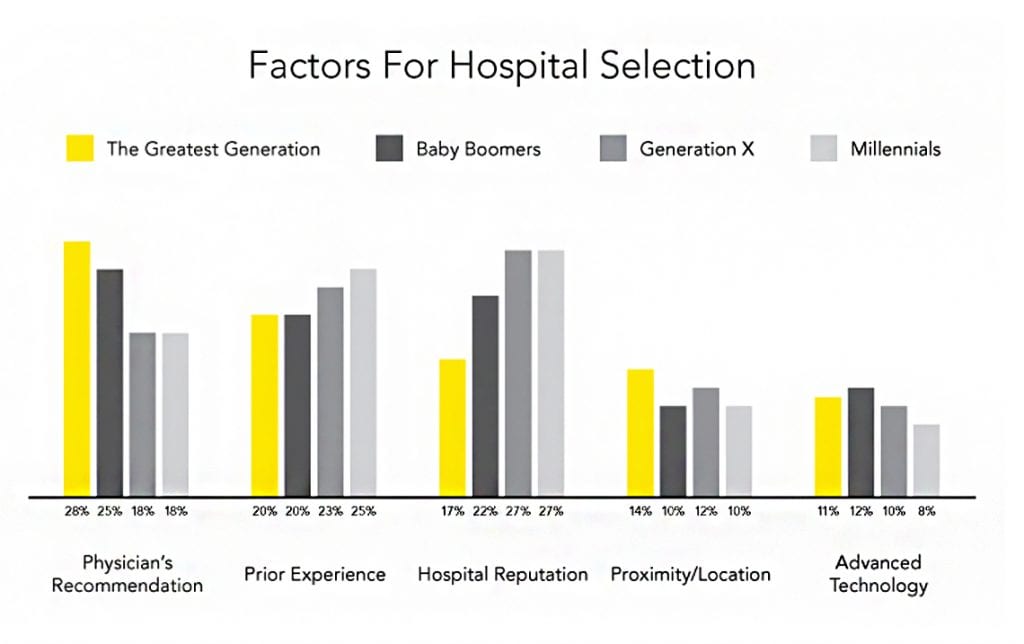If there’s one word millennials use to describe healthcare it would be “expensive”. This is also the
Unless you’re a regular patient at the hospital, chances are, you’ll need to visit their site for details and medical assistance present. Pew Research Center findings reveal that 72% of internet users search for health information online and 52% search for health information using mobile devices. 1 out of 5 netizens consider online reviews and rankings of physicians before deciding on who to set an appointment with.
In order to draw more patients towards your community, your website should be a combination of news, entertainment and marketing. Talk about what interests them. Include updates about the latest trending topics, health reports, and medical innovations. WebMD and Mayoclinic are currently reported as the top two most visited medical websites.
So, rather than promoting the hospital, promote your physicians. This can be achieved by expanding outlets for patients to choose and evaluate doctors. Doctors should be able to choose the environments they’d be most comfortable in. In order to be reached, you must reach out too. Don’t be afraid to reach out through channels such as emails, video calls and social media networks. Communication is a meaningful component in clinical practice. Virtual connections and networking aside, make sure to still keep your professionalism in check. Know when something is better of being discussed in person than online.
Social Medical Media
Hospitals, clinics and health networks need to increase and improve their online presence and exposure. 40% of millennials use social media for any health related purpose and 16% use social media to learn more about a specific health problem. Getting the undivided attention of Gen Y is still becoming a harder feat. There’s no doubt that mobile users are a distracted bunch, constantly switching between chores, apps and devices.
Similar to Rate My Professors used by university students for teachers, millennials turn to feedback and reviews on doctors from relatives and friends who have been under their care too. After all, it is the doctors that make the hospital.
Studies show that millennials are the most vulnerable and trusting when it comes to advertising, both traditional and digital. Not sure how to appeal to their emotions? Make an ad in video form, of something that will tug at their heartstrings. Millennials are avid video watchers and visual beings. What better way to get their attention than something they can immediately relate with? Sometimes, it’s those photos videos that make them realize they even needed the service or product at all.
Sponsor or Be Sponsored
Rather than relying on YouTube to do all the advertising for you, tap into other most used social media apps like Twitter, Instagram and Facebook, too. First use Twitter to build your audience. It’s easier to find, follow and target users by category, interest and industry. One hashtag can go a long way, especially if it becomes a trending topic.
Since its launch in 2010, Instagram has over six hundred million users. It’s come a long way from being just platform for sharing aesthetically pleasing photos – users are making a business out of it. Just like Twitter greatly utilizes the hashtag feature, using it on Instagram will help maximize one’s exposure, no matter what the nature of your business is. If one of your resident doctors has abundance of followers, use it to your advantage (but don’t abuse it).
Building relationship is key, but also make sure you balance written content and visuals. What use will your graphics serve if your content fails? Never forget the digital media motto: content is king. How-to articles or self-help tips should be supported with screenshots, rather than just written instructions. Better yet, provide a step-by-step video as guide.
PerhAPPS You Should Check Somewhere Else
The moment we start feeling something unusual going on in our body, our first instinct is to check for diagnosis and symptoms online. “Google it” doesn’t only apply to random queries on trivia you want to confirm anymore.
Physically visiting doctor is considered inconvenient or a hassle. I was (and still am) one of the many who hated setting my own appointments thru phone calls. Thanks to technology, these can be done virtually, by booking appointments through mobile apps. Millennials would rather communicate and interact virtually, so live chat boxes on medical websites and hospital web pages are also good alternatives. Telehealth, or the option of seeing a doctor virtually, is a rising trend as well.
Typing down hospital on the app store usually show games as results, instead of actual hospitals and medical applications. Due to lack of optimization, the concept of giving access through apps still has a limited scope though, and can only reach a certain audience.
Considering a Cure
Millennials prefer discounted, cost-effective and short term diagnosis that’ll save them more money. If self-diagnosing does the trick, why bother getting an actual check up, right? When it comes to working out health care problems generation Y wants immediate solutions.
We make up for that frugality by adjusting our lifestyle even though we may be frugal in terms of healthcare. As healthcare providers, your services should also be extending your services beyond the walls of the hospital. Technology and media will always provide a way out when it comes to closing the gap between generations.



